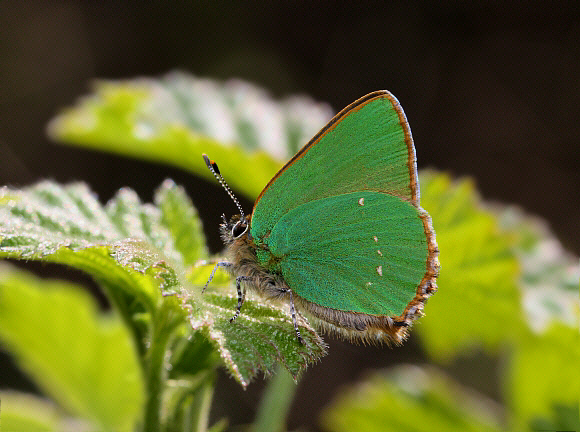 Green Hairstreak Callophrys rubi, male, Magdalen Hill Down, Hampshire – Adrian Hoskins
Green Hairstreak Callophrys rubi, male, Magdalen Hill Down, Hampshire – Adrian Hoskins
Introduction
The genus name of this delightful little butterfly – Callophrys – is Greek for “beautiful eyebrows” and the species name rubi refers to Rubus ( bramble ), one of the caterpillars foodplants.
The Green Hairstreak never displays it’s brown upperside except when in flight. The green colour of the underside ( like the blues and coppers of other Lycaenids ) is produced by light refracting and reflecting from a microscopic lattice within translucent wing scales. The iridescent colouring varies in hue according to the directional qualities of the light and the angle of view. The butterfly can thus appear to be metallic apple-green, turquoise or emerald, when viewed from various angles.
Some individuals known as form caecus have plain undersides, but on others the wings are marked with a row of white dots, often edged with reddish – these are called form punctate.
The sexes are almost identical, but the male has a small patch of scent scales in the discal cell of the upperside forewing. This is also visible in certain lighting conditions in the form of a little raised pad in the cell on the underside.
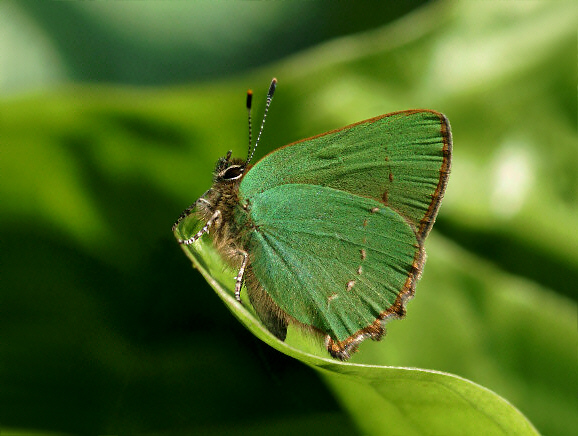 Green Hairstreak Callophrys rubi, male, Magdalen Hill Down, Hampshire – Adrian Hoskins
Green Hairstreak Callophrys rubi, male, Magdalen Hill Down, Hampshire – Adrian Hoskins
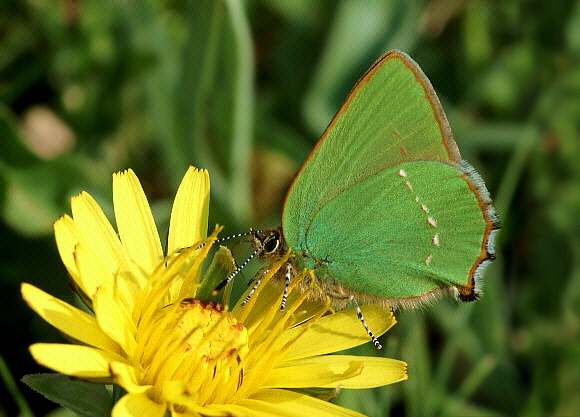 Green Hairstreak Callophrys rubi, female, Cerne Abbas, Dorset – Adrian Hoskins
Green Hairstreak Callophrys rubi, female, Cerne Abbas, Dorset – Adrian Hoskins
The butterfly is widely distributed in Europe, all the way from the Mediterranean islands to the far north of Norway and Sweden. It also occurs in Morocco and Algeria, and in most of temperate Asia. There are many closely related species elsewhere in the world, including the unfortunately named Sad Green Hairstreak Cyanophrys miserabilis of North America, and several neotropical species.
In southern France, Spain, Portugal, Morocco and Algeria it can be confused with Chapman’s Green Hairstreak Callophrys avis, which occurs in dry scrubby areas and feeds as a larva on Arbutus. They can be separated by examination of the eye borders, which in rubi are white, but in avis are reddish. The white dotted line on the underside is placed centrally in avis, but in the post-discal area in rubi.
Habitats
The butterfly occurs throughout most of the British Isles, but is quite localised, although the range of habitats and larval foodplants used is very wide.
It is commonest on dry heathland, and on scrubby south-facing hillsides or warm sheltered valley bottoms, particularly favouring habitats with hedgerows of hawthorn, blackthorn, bramble, elder or gorse.
Most colonies are small comprising no more than about 10-20 adults at peak season. Many are even smaller, particularly at marginal habitats – e.g. along railway cuttings, in woodland clearings or at abandoned chalk quarries. At a few moorland sites in Cornwall and Cumbria however much larger populations exist, numbering dozens or even hundreds of adults.
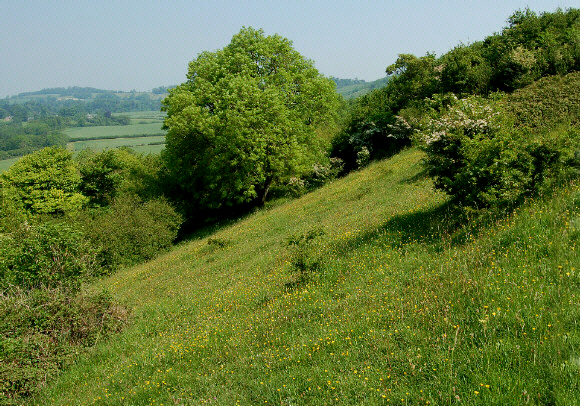 South facing chalk grassland slopes like this are ideal Green Hairstreak habitats – Adrian Hoskins
South facing chalk grassland slopes like this are ideal Green Hairstreak habitats – Adrian Hoskins
Lifecycle
The butterflies emerge in early April in forward seasons, but may be delayed until mid May in cool wet springs. They normally remain on the wing until early June.
Females roam widely over their habitat, laying their eggs singly on the leaves or flower buds of the various foodplants, including bird’s foot trefoil Lotus corniculatus, common rockrose Helianthemum chamaecistus, dogwood Cornus sanguinea, buckthorn Rhamnus catharticus, gorse Ulex europaeus, and broom Cytisus scoparius. On moorlands and heaths the main foodplant is bilberry Vaccinium myrtillus, and in woodlands bramble Rubus fruticosus is commonly used.
At Levin Down in Sussex, I watched a particular female ovipositing over a half hour period on a hot sunny morning in May 2006. She flew back and forth over a 20×50 metre strip of hillside, carefully selecting each egg-laying site, always choosing to lay on leaves of rockrose, despite the presence of bird’s foot trefoil and other known foodplants.
At Magdalen Hill Down, I watched another female behave in a similar manner, depositing her pale green eggs meticulously onto the upper surface of rock rose leaves, inserting them into the crevice formed where the base of the leaves emerges from the stems.
At both sites the eggs were laid on plants growing on ant-hills. This is probably because ant-hills tend to be warmer than surrounding areas, but could also be influenced by an association between the larva and ants – many Lycaenid larvae are “milked” by ants, which drink a sweet secretion produced from a “honey gland” on the back of the larva.
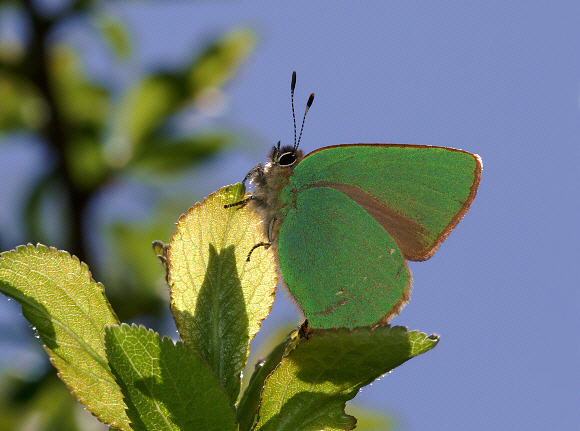 Green Hairstreak Callophrys rubi, male, Purbeck hills, Dorset – Adrian Hoskins
Green Hairstreak Callophrys rubi, male, Purbeck hills, Dorset – Adrian Hoskins
Like other Lycaenid larvae, that of the Green Hairstreak is plump, like a woodlouse. It is green, and marked with rows of yellow dots on the back and sides. The larva feeds on the flower buds, flowers or tender young leaves of common rockrose, gorse, bilberry, bird’s foot trefoil, dogwood, broom and various vetches. At some sites the larvae feed on buckthorn berries, in which they make a hole through which they extract the contents.
The larva leaves the foodplant to pupate just under the surface of the ground, often where there are stones or fallen leaves. The pupa has the ability to produce a squeaking noise – this was once thought to be a defence mechanism against ants and beetles, but research on other Lycaenids that also share this behaviour suggest that the pupa is actually “singing” to attract the attention of ants, which carry it into their nests below the ground. The pupa secretes a sugary coating which the ants drink, and in exchange the pupa gains protection from other insects that would not dare enter the ants nest.
Adult behaviour
The flight period is from early April until early June at the warmest sites; or from early May until late June at cooler or northern sites.

Green Hairstreak Callophrys rubi, Magdalen Hill Down, Hampshire – Adrian Hoskins
Males and females behave quite differently. Males establish territories, typically perching on gorse flowers, or on the foliage of hawthorn, blackthorn, elder, privet and various other bushes, often at the bottom of hills. On sunny mornings they use these perches as vantage points from which they dart up to intercept other small insects, including bees, flies, and various butterfly species, as well as other Green Hairstreaks.
When perching they regulate their body temperature by tilting their wings – in cooler conditions they are angled to present the maximum wing area to the sun but in hot conditions they are angled edge on to minimise heat absorption. This lateral-basking technique has the additional advantage that the wings cast no give-away shadows, helping the already superbly camouflaged butterfly to blend even more perfectly against its background and avoid being detected by predators.
Often several males will have overlapping territories, so male-male encounters are frequent. When males meet, they engage in a frenzied battle, zipping about in tight circles, each trying to outwit and outmanoeuvre the other with constant changes of direction. Each male changes his territory several times throughout the day in response to the changing position of the sun which causes each perch to become shaded at some stage. Thus the butterflies frequently find themselves intruding into each other’s territories and often both males believe they have “ownership” of a particular spot. At such times their battles can be protracted and intense. The pair will commonly spiral rapidly to a height of about 4 metres, then break away. Invariably however they soon meet again and continue the battle which may last for several minutes. During this time they may chase each other up to 4 or 5 metres horizontally from the point where the conflict began. Eventually the weaker male gives up and leaves the vicinity, and the victor returns to his original perch.
I have not observed courtship, but it is likely that the sexes copulate without any pre-nuptial ritual. On several occasions I’ve found copulated pairs settled on low herbage, but they are difficult to detect due to the very effective cryptic colouration.
Females spend most of their time fluttering inconspicuously just above the ground in search of egg-laying sites, and are seen far less often than the males.
Both sexes nectar at a wide range of spring flowers including bird’s foot trefoil, horseshoe vetch, common vetch, gorse, common rock rose, elder, holly, wayfaring tree, bluebells, cowslip, wood forget-me-not, dandelion, daisy and hawthorn.
In Dorset I have observed Green Hairstreaks flying around elms and field maples at the bottom of chalk hills in late afternoon, and settling for long periods on ivy foliage on the higher branches of small oaks, but have not been able to determine whether both sexes indulge in this activity.
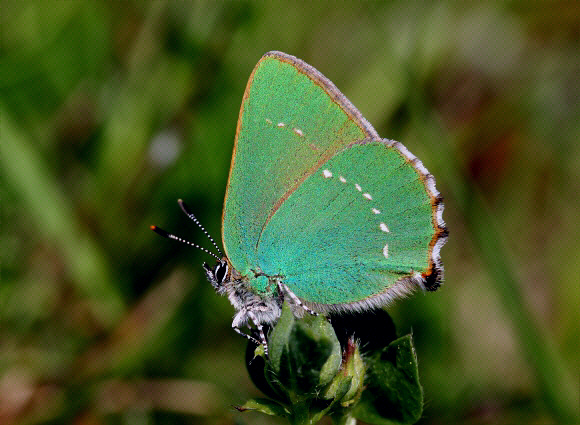 Green Hairstreak Callophrys rubi, Cissbury Ring, Sussex – Adrian Hoskins
Green Hairstreak Callophrys rubi, Cissbury Ring, Sussex – Adrian Hoskins
